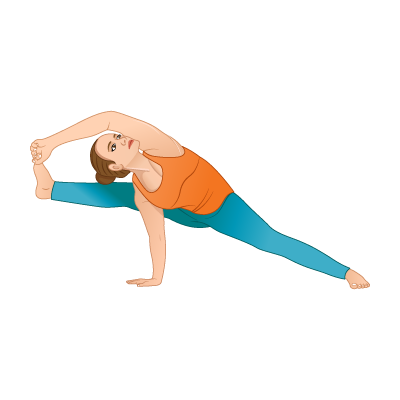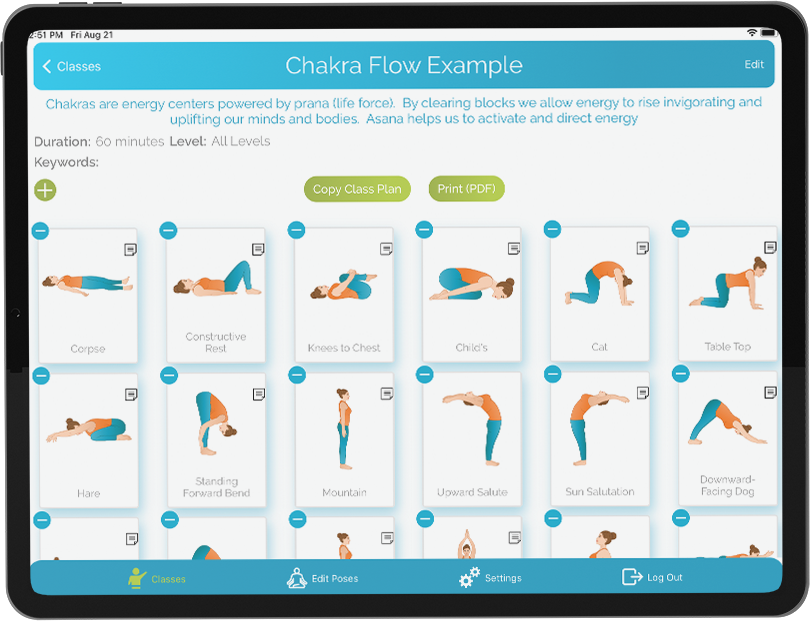Visvamitra’s Pose
Visvamitrasana

STEPS
Begin in a lunge (right foot forward). Bring the right hand to the outside of the right foot, working the arm and shoulder under the right thigh. Turn the left foot flat. Extend the right leg in front. Raise the left arm upwards and turn the head towards the fingertips. To come out of the pose, lower the left hand and then the right foot to the ground. Unbind the right arm and shoulder, returning to the lunge. Repeat the other side.
TEACHER QUEUES
VISUALIZATION COMMENTS
This is a challenging pose named after a famous sage whose will and determination helped him to overcome many obstacles. So it is possible to approach this pose in stages which represent those obstacles. Begin with lunge representing Vashvamitra’s humble beginnings as a warrior, then to lunge with arm bind or lunge on knee with front leg extended to represent his becoming a royal sage, then on to triangle pose with both hands on the ground or triangle with one leg extended (using a wall) when he successfully achieved maharishi or great sage and finally to the full pose where he gains brahmarishi status.
TECHNICAL COMMENTS
When binding from the lunge position, the shoulder must come under the thigh and pressing against the upper arm. The head is raised with the neck long. To lift the right foot off the floor, straighten the leg and squeeze it against the arm. The foot should not touch the ground. Now turn the left foot flat and bring the left arm along the side torso. Push the heel and side of the foot into the ground and spiral the chest upwards. Raise the hand upwards and then turn head and eye gaze towards the extended fingers.
BENEFIT COMMENTS
- Strengthens arms and legs
- Stretches and tones sciatic nerves, legs and hips
- Strengthens core muscles
- Improves concentrations and balance
WATCH OUT FOR
- Leg slipping off arm (ensure shoulder is under right thigh)
- Front foot on the ground (use modified positions)
- Torso curling forward (practice against a wall)
CONTRAINDICATIONS
- Shoulder and wrist injuries
- Hamstring injuries
- Lower back pain
MODIFICATIONS
- ½ Vishvamitra’s pose is practiced with back leg bent (on one knee)
- ¾ Vishvamitra’s pose is practiced with front foot pressed against the wall
- Place a brick under front hand before lifting the leg up
VARIATIONS
- Full Vishvamitrasana : Continue to spiral the chest upwards. Bring right hand in back of the hand to hold the left foot (repeat other side)
- Supta Vishvamitrasana: Reclining on right side, extend the left leg, bring the left hand in front of the chest. The right arm and hand come around the back of the head to hold the left toe. (repeat other side)
- Seated Vishvamitra: From heron or compass pose. Left leg is extended, the right arm and hand come around the back of the head to hold the left foot.
YOGA COUNTER POSES
- Plank-Downward Dog –upward facing dog or cobra (Vinyasa transition)
- Reclining hand-to-toe-pose (Supta padangusthasana)
- Reclining cobblers pose (Supta baddha konasana)
- Child pose (Balasana)
Written By: Brenda Hamlet
RYT 200 yoga teacher and journalist in Oxford, England. More information about Brenda can be found at www.pret-a-yoga.com



